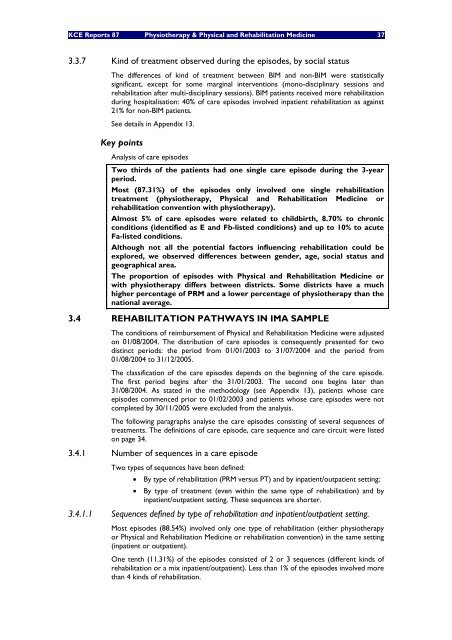Het gebruik van kinesitherapie en van fysische geneeskunde ... - KCE
Het gebruik van kinesitherapie en van fysische geneeskunde ... - KCE
Het gebruik van kinesitherapie en van fysische geneeskunde ... - KCE
You also want an ePaper? Increase the reach of your titles
YUMPU automatically turns print PDFs into web optimized ePapers that Google loves.
<strong>KCE</strong> Reports 87 Physiotherapy & Physical and Rehabilitation Medicine 37<br />
3.3.7 Kind of treatm<strong>en</strong>t observed during the episodes, by social status<br />
The differ<strong>en</strong>ces of kind of treatm<strong>en</strong>t betwe<strong>en</strong> BIM and non-BIM were statistically<br />
significant, except for some marginal interv<strong>en</strong>tions (mono-disciplinary sessions and<br />
rehabilitation after multi-disciplinary sessions). BIM pati<strong>en</strong>ts received more rehabilitation<br />
during hospitalisation: 40% of care episodes involved inpati<strong>en</strong>t rehabilitation as against<br />
21% for non-BIM pati<strong>en</strong>ts.<br />
See details in App<strong>en</strong>dix 13.<br />
Key points<br />
Analysis of care episodes<br />
Two thirds of the pati<strong>en</strong>ts had one single care episode during the 3-year<br />
period.<br />
Most (87.31%) of the episodes only involved one single rehabilitation<br />
treatm<strong>en</strong>t (physiotherapy, Physical and Rehabilitation Medicine or<br />
rehabilitation conv<strong>en</strong>tion with physiotherapy).<br />
Almost 5% of care episodes were related to childbirth, 8.70% to chronic<br />
conditions (id<strong>en</strong>tified as E and Fb-listed conditions) and up to 10% to acute<br />
Fa-listed conditions.<br />
Although not all the pot<strong>en</strong>tial factors influ<strong>en</strong>cing rehabilitation could be<br />
explored, we observed differ<strong>en</strong>ces betwe<strong>en</strong> g<strong>en</strong>der, age, social status and<br />
geographical area.<br />
The proportion of episodes with Physical and Rehabilitation Medicine or<br />
with physiotherapy differs betwe<strong>en</strong> districts. Some districts have a much<br />
higher perc<strong>en</strong>tage of PRM and a lower perc<strong>en</strong>tage of physiotherapy than the<br />
national average.<br />
3.4 REHABILITATION PATHWAYS IN IMA SAMPLE<br />
The conditions of reimbursem<strong>en</strong>t of Physical and Rehabilitation Medicine were adjusted<br />
on 01/08/2004. The distribution of care episodes is consequ<strong>en</strong>tly pres<strong>en</strong>ted for two<br />
distinct periods: the period from 01/01/2003 to 31/07/2004 and the period from<br />
01/08/2004 to 31/12/2005.<br />
The classification of the care episodes dep<strong>en</strong>ds on the beginning of the care episode.<br />
The first period begins after the 31/01/2003. The second one begins later than<br />
31/08/2004. As stated in the methodology (see App<strong>en</strong>dix 13), pati<strong>en</strong>ts whose care<br />
episodes comm<strong>en</strong>ced prior to 01/02/2003 and pati<strong>en</strong>ts whose care episodes were not<br />
completed by 30/11/2005 were excluded from the analysis.<br />
The following paragraphs analyse the care episodes consisting of several sequ<strong>en</strong>ces of<br />
treatm<strong>en</strong>ts. The definitions of care episode, care sequ<strong>en</strong>ce and care circuit were listed<br />
on page 34.<br />
3.4.1 Number of sequ<strong>en</strong>ces in a care episode<br />
Two types of sequ<strong>en</strong>ces have be<strong>en</strong> defined:<br />
• By type of rehabilitation (PRM versus PT) and by inpati<strong>en</strong>t/outpati<strong>en</strong>t setting;<br />
• By type of treatm<strong>en</strong>t (ev<strong>en</strong> within the same type of rehabilitation) and by<br />
inpati<strong>en</strong>t/outpati<strong>en</strong>t setting. These sequ<strong>en</strong>ces are shorter.<br />
3.4.1.1 Sequ<strong>en</strong>ces defined by type of rehabilitation and inpati<strong>en</strong>t/outpati<strong>en</strong>t setting.<br />
Most episodes (88.54%) involved only one type of rehabilitation (either physiotherapy<br />
or Physical and Rehabilitation Medicine or rehabilitation conv<strong>en</strong>tion) in the same setting<br />
(inpati<strong>en</strong>t or outpati<strong>en</strong>t).<br />
One t<strong>en</strong>th (11.31%) of the episodes consisted of 2 or 3 sequ<strong>en</strong>ces (differ<strong>en</strong>t kinds of<br />
rehabilitation or a mix inpati<strong>en</strong>t/outpati<strong>en</strong>t). Less than 1% of the episodes involved more<br />
than 4 kinds of rehabilitation.

















